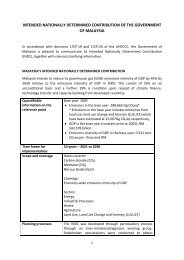RP-01638
RP-01638
RP-01638
You also want an ePaper? Increase the reach of your titles
YUMPU automatically turns print PDFs into web optimized ePapers that Google loves.
movement, which has several workshops in<br />
the area. These pumps were installed in handdug,<br />
4.9-foot (1.5-m) diameter wells. The<br />
wells were lined with a concrete casing and<br />
covered with a removable concrete cover;<br />
thus, if the pump breaks down, the villagers<br />
can continue to obtain water with a bucket.<br />
Two factors appear to influence the installation<br />
of the pumps in this manner. First,<br />
because the pumps are still experimental and<br />
may fail, this type of well offers some<br />
assurance of a constant water supply. Second,<br />
because villagers are not familiar with the<br />
method of drilling bore-hole wells, there was<br />
no local expertise available for trying this<br />
method of installation.<br />
The construction of open wells increases<br />
the installation cost and places a limit on the<br />
depth that can be obtained. The average depth<br />
of 100 wells examined was about 16-23 feet<br />
(5-7 m) and the static water level was 10-16<br />
feet (3-5 m) below the surface.<br />
The Sarvodaya movement plans to install<br />
an additional 250 handpumps in various<br />
villages. The cost of installation will probably<br />
be borne by foreign-based aid agencies.<br />
Economic analysis<br />
Financial and technical information regarding<br />
the three handpump models are shown in<br />
Table 1. These pumps differ in their aboveground<br />
components, although the belowground<br />
components are essentially the same.<br />
Installation charges are nearly 300% of the<br />
cost of the pump, whereas yearly maintenance<br />
charges are about 23% of the total pump cost.<br />
Water supply situation<br />
Of the 12.7 million people in Sri Lanka in<br />
1980, 73% lived in rural areas. There were<br />
1420 000 rural households, each containing<br />
an average of seven persons, and only 2% of<br />
the rural population was currently served by<br />
treated piped water.<br />
The use of handpumps is a relatively new<br />
phenomenon, only about 2500 have been<br />
installed in Sri Lanka. Of these, only about<br />
1500 (60%) are still functioning. If it is<br />
assumed that one handpump serves about 50<br />
families, then only 75 000 families or about<br />
5% of the rural population is currently being<br />
served.<br />
The United Nations Children's Fund<br />
(UNICEF) is currently involved in a program<br />
to install a sizeable number of deep-well<br />
handpumps in the northern half of the island.<br />
Table 1. Information on three handpump models<br />
tested in Sri Lanka.'<br />
Model<br />
Item Vi L1 L3<br />
Installation ($) 283 269 241<br />
Pump ($) 60 100 120<br />
Yearly maintenance ($) 17 25 21<br />
Expected life (years) 7 9 9<br />
Persons served/pump 20 40 25<br />
Avg water use/<br />
person/day (L) 25 66 35<br />
Water pumping rate (Llminute) 8 8 8<br />
Note: Installation cost estimated for an average depth of<br />
5 m (16.4 feet). Expected life is based on the project leader's<br />
estimates.<br />
'1 L = 0.22 gallon.<br />
To date, 600 holes have been dug and 300<br />
pumps installed. These wells, which average<br />
more than 49 feet (15 m) deep, are situated<br />
about 0.5 mile (800 m) apart and each one<br />
serves about 50 households. The most<br />
common pump is the India Mark II, which<br />
costs approximately $400 per pump (excluding<br />
tax). UNICEF plans to have a two-tier<br />
program for the maintenance of these pumps:<br />
a village pump mechanic to attend to minor<br />
repairs and a regional pump inspector<br />
responsible for major repairs. The truckmounted<br />
drilling rig required for this program<br />
was imported from Europe at a cost of<br />
about $250 000. A rig can drill up to about<br />
80 holes per year at an estimated cost of<br />
$1000-1500 per well.<br />
Potential markets<br />
The potential market for handpumps in Sri<br />
Lanka is sizeable. The only limitation appears<br />
to be that 75% of the country is relatively dry;<br />
however, 70% of the population is concentrated<br />
in the wet zone. If 50% of the rural<br />
population were served by handpumps, the<br />
estimated number of additional handpumps<br />
required in Sri Lanka would be approximately<br />
14000, 15000, and 17 000 in 1982, 1985, and<br />
1990, respectively. These estimates are<br />
derived from the assumptions that the rural<br />
population is growing at an annual rate of<br />
2.5% and that the number of families served<br />
per pump remains at 50. If the objective were<br />
to provide one handpump per 10 families,<br />
these estimates would have to be increased by<br />
500%.<br />
The government apparently places high<br />
priority on handpump development for the<br />
rural areas of the country. However, its<br />
58



